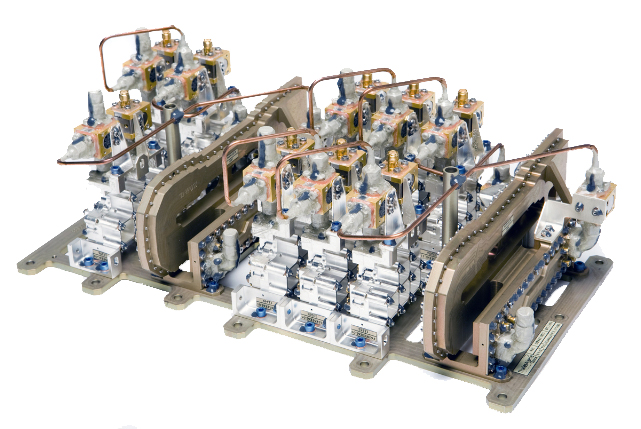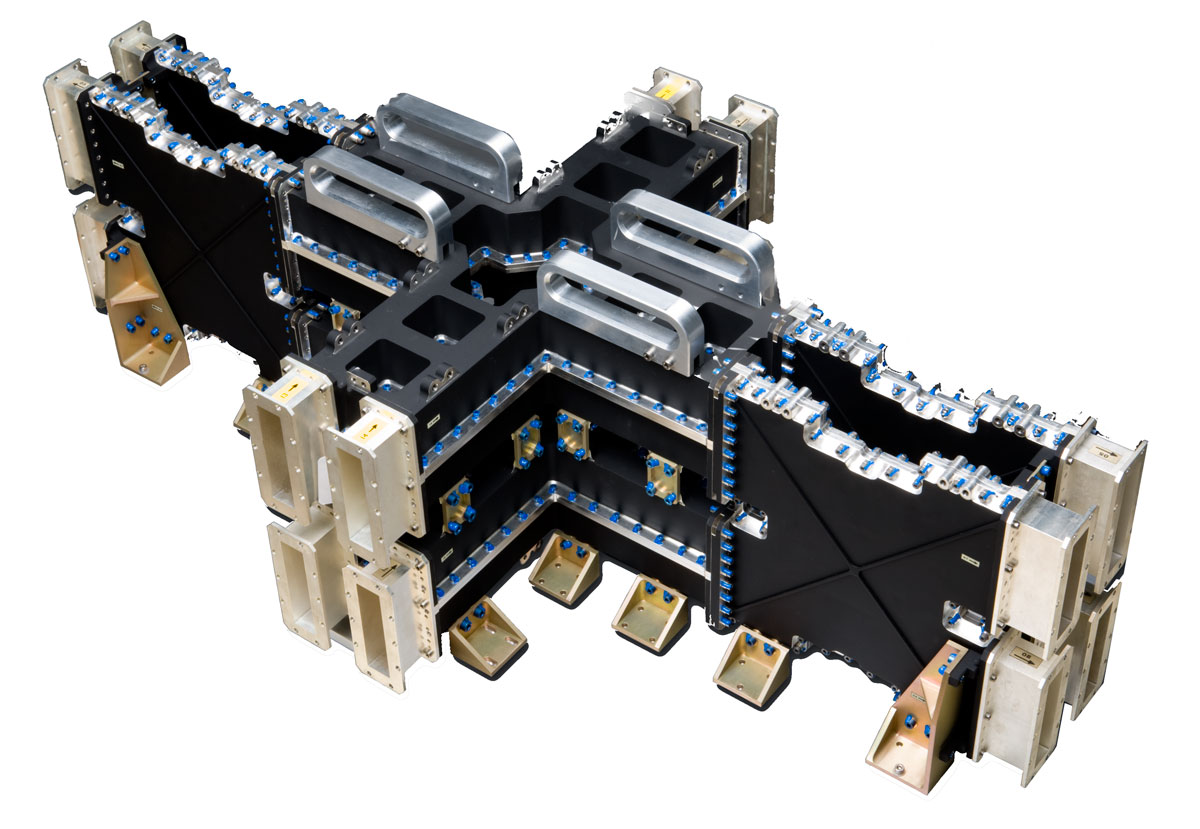
To TRAK, heritage means the possession of a demonstrable record of supplying products into specific applications and the ability to produce and share, if appropriate, this record with interested parties as a mark of the Company’s expertise and experience.
TRAK’s heritage data is available to all interested customers and can be provided as a function of product type, topology, operating frequency, topology and of course application. Contact TRAK today for the most up to date information.
Space Heritage
Space qualified Passive RF & Microwave products have been designed and manufactured by TRAK in Dundee since 1993 and supplied to customers on every continent. Originally based on a core expertise in Ferrite Isolators & Circulators the capability and product range has expanded over the years to include Couplers, Loads & Terminations and products operating to over 52 GHz.
Since TRAK’s first flight model was delivered in 1994 over 160,000 FMs have been delivered to some 33 customers and have been/will be used aboard an estimated 774 payloads across the spectrum of terrestrial orbiting applications (LEO, MEO & GEO) including GNSS, broadcast services, telecommunications, earth observation; defence and security, resource planning and disaster management and interplanetary/ deep space missions. Details of most of these are included in our Space heritage document and available to select existing and prospective customers. The following table was updated for flight models supplied to 31st December 2016.
| Topology | Coaxial | Microstrip | Waveguide | Stripline | Total |
| Quantities of FM supplied | 47463 | 54372 | 12601 | 40683 | 163502 |
The assemblies below are a selection of the applications TRAK has supplied FMs to.
The following are examples of the range of scientific missions that TRAK has participated on, and is involved with, engaged in investigating our own and other planets and bodies that make up our solar system.
| Program | Comment | Date |
| CASSINI | Planetary observation mission | 1994 |
| SOHO | Space-based observatory to study the sun (together with NASA) | 1995 |
| ERS 2 | An earth-observing satellite, the successor to ERS-1 | 1995 |
| CLUSTER 2 | A group of four probes studying the magnetosphere | 1996 |
| NEAR | Near earth asteroid rendezvous | 1996 |
| MARS PATHFINDER | Mars rover mission | 1996 |
| HUYGENS | A space probe to Saturn’s moon Titan | 1997 |
| ARD | A test bed for re-entry technologies | 1998 |
| XMM NEWTON | X-ray observatory satellite which participates in the Cosmic Evolution Survey | 1999 |
| ARTEMIS | Europe’s most advanced telecommunication satellite | 2001 |
| PROBA 1 | Technology demonstration mini-satellite, the first satellite in the PROBA series | 2001 |
| INTEGRAL | The first space observatory that can simultaneously observe objects in gamma rays, X-rays and visible light | 2002 |
| ENVISAT | The world’s largest and most complex environmental satellite | 2002 |
| SMART 1 | A lunar space probe testing new propulsion technology | 2003 |
| MUSES-B (HAYABUSA) | Comet ltokawa rendezvous mission returning to Earth in 2010 | 2003 |
| ROSETTA | Space probe that will explore comet 67P/Churyumov-Gerasimenko in 2014 | 2004 |
| VENUS EXPRESS | A space probe to Venus and arrived in orbit around Venus in April 2006 | 2005 |
| GIOVE A | Experimental satellite launched Dec 2005 as forerunner for the Galileo positioning system | 2005 |
| METOP A | The first polar orbiting satellite dedicated to operational meteorology. A satellite to study temperature and humidity, wind speed and direction, ozone and other trace gases on Earth | 2006 |
| COROT | A space telescope for detecting rocky exoplanets larger than Earth. Launched Dec 2006. A project led by the French space agency CNES. | 2006 |
| ALOS-1 | ALOS will be used for cartography, regional observation, disaster monitoring and resource surveying | 2006 |
| SOLAR-B (HINODE) | Three-year mission to explore the magnetic fields of the Sun | 2006 |
| SELENE (KAGUYA) | Japan’s first large lunar explorer | 2007 |
| GIOVE B | The second Galileo in-orbit validation satellite launched on April 2008 | 2008 |
| CHANDRAYAAN-1 | Instruments on Chandrayaan-1 – Indian space probe to the Moon launched on October 2008, functional until August 2009 | 2008 |
| PROBA 2 | Second satellite in the PROBA series, launched together with SMOS | 2009 |
| SMOS | Earth Explorer mission launched on November 2009 designed to measure Soil Moisture and Ocean Salinity | 2009 |
| GOCE | A mission designed to measure the Earth’s gravity field, launched on March 2009 | 2009 |
| HERSCHEL | A space telescope observing in the far-infrared | 2009 |
| PLANCK | Cosmic Microwave Background explorer, after COBE & WMAP | 2009 |
| GOSAT (IBUKI) | It measures densities of carbon dioxide and methane in the Earth’s atmosphere | 2009 |
| CRYOSAT 2 | A three-year radar altimetry mission to determine variations in the thickness of the Earth’s continental ice sheets and marine ice cover; built to replace Cryosat after launch failure | 2010 |
| PLANET-C (AKATSUK) | AKATSUKI (PLANET-C) is the next planetary exploration project for the Martian orbiter NOZOMI | 2010 |
| JUNO | Mission to the Jovian moon | 2011 |
| METOP-B | The second satellite in the EUMETSAT Polar System (EPS), launched in 2012 | 2012 |
| GAIA | Cataloguing and astrometry of starts in our galaxy | 2013 |
| PROBA V | New satellite in the PROBA series to observe the ground vegetation on the global scale | 2013 |
| SWARM | Mission to measure Earth’s magnetic field | 2013 |
| SPRINT-A (HISAKI) | Used to study the composition of the atmospheres and the behaviour of the magnetospheres of the planets of the Solar System | 2013 |
| SENTINEL 1a | The first component of the GMES Space Segment, carrying a Synthetic Aperture Radar (SAR) in C-Band, that will provide all-weather, day and night radar imaging for land and ocean services | 2014 |
| EARTHCARE | Collaboration with JAXA to improve understanding of the cloud, radiative and aerosol processes that affect the Earth’s climate | 2014 |
| ALOS-2 (DAICHI) | The Advanced Land Observing Satellite-2 (ALOS-2) is follow-on mission from the “DAICHI” | 2014 |
| LISA PATHFINDER | AKA Smart-2, technology demonstrator for the LISA mission | 2014 |
| GALILEO | Satellite positioning system | 2014 |
| ADM AEOLUS | Will measure global wind profiles | 2015 |
| BEPI COLOMBO | Space probe to Mercury (togethr with JAXA) | 2015 |
| ASTRO-H | ASTRO-H enables high sensitivity observations of celestial sources across a wide energy range, from X-rays to gramma-rays | 2015 |
| EXOMARS | Mars spacecraft and rover to be launched 2016. | 2016 |
| SOLAR ORBITER | An orbiter to examine the polar regions of the Sun. | 2017 |
| SOLAR PROBE PLUS | A robotic spacecraft to probe the Sun’s outer corona. | 2018 |
| EUCLID | An ESA mission to map the geometry of the dark universe. | 2020 |


